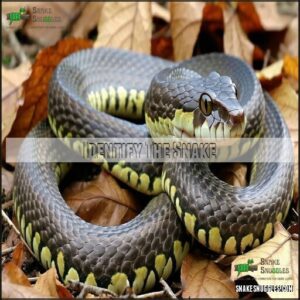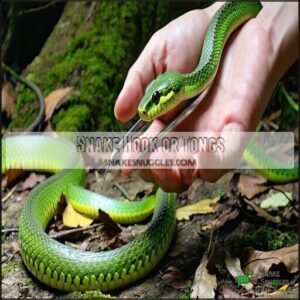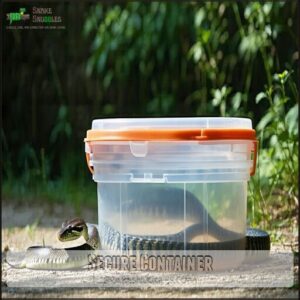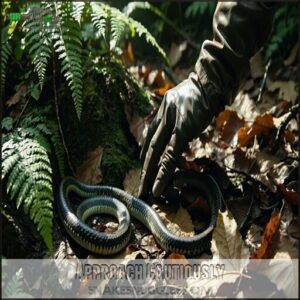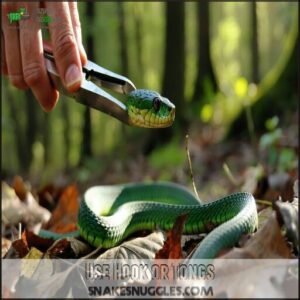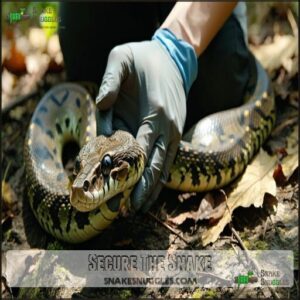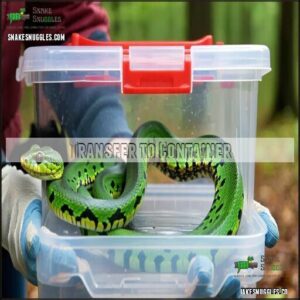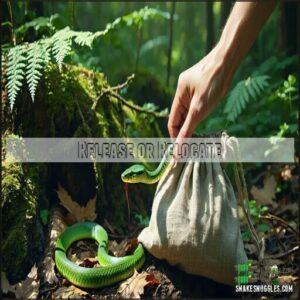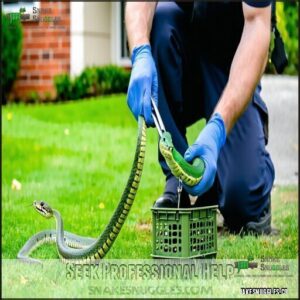This site is supported by our readers. We may earn a commission, at no cost to you, if you purchase through links.
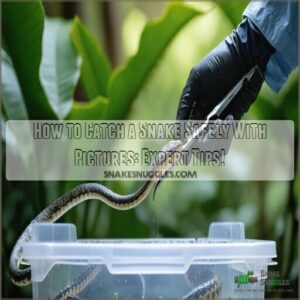
First, identify whether it’s venomous by checking its head shape and pupils.
You’ll need thick gloves, a snake hook or tongs, and a secure container.
Approach slowly and watch for warning signs like coiling or hissing.
Use your hook to gently pin the snake behind its head, staying out of striking range.
Carefully grasp the snake just behind its head, supporting its body.
Quickly guide it head-first into the container and secure the lid tightly.
If you’re unsure or dealing with a potentially dangerous species, it’s best to call a professional wildlife expert who knows exactly how to handle these slithery situations.
Table Of Contents
- Key Takeaways
- How to Catch a Snake Safely With Pictures?
- Identify The Snake
- Gather Supplies
- Approach Cautiously
- Pin The Snake
- Secure The Snake
- Transfer to Container
- Release or Relocate
- Seek Professional Help
- Frequently Asked Questions (FAQs)
- How to catch a snake safely?
- How do you catch a venomous snake barehanded?
- Should you use a snake trap?
- What if you can’t catch a snake?
- How do you catch a snake without a bodily injury?
- How to catch a garden snake?
- What Are the Common Mistakes to Avoid When Catching a Snake?
- How Can I Ensure My Safety While Catching a Snake?
- Are There Any Legal Considerations or Permits Required for Catching Snakes?
- What Should I Do if I Am Bitten by a Snake While Attempting to Catch It?
- Conclusion
Key Takeaways
- You’ll need specialized gear before attempting to catch a snake, including thick gloves, a snake hook or tongs, and a secure container with a tight-fitting lid.
- Always identify the snake species first, as venomous snakes require professional handling and pose significant risk to untrained individuals.
- Approach the snake slowly and cautiously, using precise movements to pin it behind the head while staying out of its striking range, maintaining control and minimizing stress.
- When in doubt about the snake’s species or your ability to handle it safely, don’t hesitate to contact a professional wildlife expert who can remove the snake without risking your or the snake’s safety.
How to Catch a Snake Safely With Pictures?
When encountering a snake, your safety hinges on calm preparation and smart techniques.
Snake catching isn’t for the faint-hearted—it demands respect, knowledge, and the right gear.
Snake catching is an art of courage, wisdom, and calculated respect for nature’s most misunderstood creatures.
A snake hook or tongs lets you maintain a safe distance, while thick gloves shield your hands from unexpected bites.
Have a secure container ready, designed to transport your slithery visitor without drama.
Remember, venomous species require professional help.
By understanding snake behavior and using proper handling techniques, you’ll navigate this challenge with confidence and care.
Identify The Snake
Let’s zero in on snake identification, your first line of defense.
Reading a snake’s profile is like decoding a living puzzle. Watch for these key venomous signs and nonvenomous traits:
Snake identification is an art: read their body language, decode their danger signals, and stay alert.
- Head Shape – Triangular or rounded?
- Pupils – Slit or circular?
- Color Patterns – Unique markings?
- Behavior – Defensive or calm?
Regional species vary widely, so regional snake identification pictures can be your best friend. Pay attention to color variations and behavioral clues.
When in doubt, keep your distance and consult a local expert for snake identification and safety.
Gather Supplies
You’ll need the right gear to catch a snake safely, so let’s make sure you’re prepared with essential tools.
Grab a snake hook or tongs, thick gloves, and a secure container to handle the situation like a pro.
Snake Hook or Tongs
After you’ve pinpointed the snake species, your next safety move is selecting the right snake hook or tongs.
These snake catching equipment are your lifeline when maintaining a safe handling distance.
Choose hook materials like durable aluminum or stainless steel, which offer strength without excess weight.
Snake hook techniques vary, but the goal’s always consistent: control without contact.
Tong design matters—look for models with adjustable grip strength that suit different snake species specificity.
For most situations, a 36-48 inch hook works perfectly, allowing you to pin and maneuver without getting too close.
Remember that snakes require specific humidity levels to facilitate proper shedding.
Pro tip: Practice your snake handling safety techniques with a rubber snake first.
Your confidence and precision can make all the difference between a smooth capture and a risky encounter.
Secure Container
After selecting your snake hook, grab a reliable container that’s your serpent’s temporary fortress.
Your container should be:
- FDA-approved food-grade plastic with thick walls
- Large enough to comfortably accommodate the snake
- Equipped with secure, locking lid mechanisms
Size matters when trapping snakes—a 30-35 quart tub works perfectly.
Choose a durable, well-ventilated bin with snap-on adapters that keeps your slithery friend safely enclosed during transport.
Selecting the right transport options is paramount.
Remember, this isn’t just a box—it’s a mobile snake sanctuary.
Thick Gloves
Your snake-handling gloves are your first defense against unexpected bites.
Leather, Kevlar, and heavy cotton offer the best combination of bite resistance and dexterity for snake catching. Pro handlers know these gloves protect your hands while allowing precise movements during snake handling.
Choose gloves that fit snugly—too loose means potential risk, too tight limits flexibility.
For enhanced safety, consider specialized handling equipment designed to prevent injuries.
Invest in quality thick gloves designed specifically for snake safety; they’re an affordable insurance policy against potential snake encounters, typically costing under $20.
Remember: proper protection starts with your hands.
Approach Cautiously
You’ve gathered your tools, and now it’s time to approach the snake with surgical precision. Your mission: observe and assess without causing alarm.
- Stay cool as a cucumber
- Move like a whisper
- Read the snake’s body language
- Respect its personal space
- Trust your instincts
Your quiet environment is key.
Slow, deliberate movements prevent startling the snake.
Watch for defensive postures—coiled muscles, flickering tongue, or subtle shifts in position.
Remember, snake safety isn’t about bravado; it’s about understanding and respect.
Understanding a snake’s posture, such as a raised head signals aggression, is fundamental.
Approach cautiously, and you’ll master the art of snake handling.
Pin The Snake
When you’re ready to catch a snake, pinning is a critical technique that’ll help you control the situation safely.
You’ll want to use a snake hook or tongs to gently but firmly immobilize the snake near its head, keeping yourself out of its striking range.
Use Hook or Tongs
When you’re face-to-face with a slithery surprise, your snake hook or tongs become your best defense.
Here’s how to wield them like a pro:
- Select Wisely: Choose tools matching the snake’s size and behavior.
- Position Carefully: Slide under the snake near its head with precision.
- Control the Angle: Keep the hook or tongs flat against the ground initially.
- Maintain Composure: Move slowly and deliberately to avoid startling your scaly friend.
- Practice Makes Perfect: Familiarize yourself with your tools before real-world encounters.
Your tool’s hook material, length, and grip strength can make all the difference in safe snake handling.
You can find a suitable snake hook online.
Avoid Striking Range
After positioning your snake hook, you’ll want to master the art of handler positioning.
Keep a safe distance—at least one-third of the snake’s body length. Your reaction time matters.
Watch for subtle body language shifts like coiled tension or head-raising, which signal potential strikes.
Maintain a low, stable stance and stay hyper-aware.
These snake safety precautions can mean the difference between a smooth capture and a dangerous encounter.
Secure The Snake
When securing a snake, you’ll need to execute a precise and controlled handling technique that minimizes risk to both you and the snake.
Your goal is to grasp the snake firmly yet gently behind its head while supporting its body to prevent unnecessary stress and potential defensive strikes.
Grasp Firmly Behind Head
Master your grip when catching a snake by positioning your hand just behind its head—a critical technique for safe handling.
Here’s how to nail it:
- Read the snake’s body language carefully
- Position your grip confidently yet gently
- Control the strike zone with precise hand placement
Your steady hand prevents panic and keeps both you and the snake safe during this delicate moment.
Support Body
After securing the snake’s head, support its body like you’re cradling a delicate instrument.
Use a hook or hand to maintain a gentle mid-body grip, keeping its natural posture relaxed.
Smooth, steady movements are your secret weapon in snake catching safety.
Remember, your calm approach matters more than muscle—respect the snake’s space and minimize stress during handling.
Transfer to Container
When transferring a snake to a container, you’ll want to guide its head first to minimize stress and prevent potential escape.
Carefully slide the snake headfirst into a secure container with a tight-fitting lid, ensuring you maintain control and keep both yourself and the snake safe throughout the process. Maintain control and keep both yourself and the snake safe throughout the process.
Guide Head First
You’ll want to smoothly maneuver the snake into the container using your snake hook or tongs.
Container size matters when guiding the snake—choose one slightly larger than the snake’s length.
Angle the opening strategically, allowing the snake’s head to enter naturally.
Support the snake’s body to reduce stress and prevent injury during capture.
Keep movements slow and predictable, ensuring escape prevention while maintaining control during snake catching techniques.
Secure Lid
After carefully guiding the snake headfirst into your container, you’ll want to lock down your escape-proof fortress.
Choose containers with airtight seals and locking mechanisms that guarantee no surprise snake adventures.
Your lid should be:
- Childproof and secure
- Made of durable materials
- Tight with zero wiggle room
- Equipped with ventilation holes
- Strong enough to withstand snake movement
Double-check the seal by gently pressing down. A well-secured lid means peace of mind and prevents your slithery friend from staging a daring breakout.
Release or Relocate
When relocating a snake, you’ll want to choose a spot far from human activity that provides a safe, natural habitat for the animal.
Carefully release the snake by guiding it headfirst into an area with appropriate cover, such as a state park or wooded region at least a mile away from residential zones.
Suitable Habitat
When relocating a snake, think like a wildlife expert matching a creature to its perfect home.
Look for habitats that mirror the snake’s natural environment—forest floors, rocky outcrops, or grasslands teeming with natural predators and food sources.
Consider water availability, shelter types, and climate factors. A well-chosen release spot guarantees the snake’s survival and maintains local ecosystem balance.
Snake catching isn’t just about removal; it’s about responsible wildlife stewardship.
Away From Dwellings
After carefully pinning and securing your slithery friend, it’s time to find a new home.
Your goal? Release the snake far from human dwellings while respecting its natural habitat.
Think like a snake detective, seeking the perfect spot that mimics its original environment.
- Choose a quiet, predator-free wilderness area
- Maintain at least a mile’s distance from residential zones
- Gently guide the snake to safety without sudden movements
Wilderness relocation protects both human and reptilian residents.
Remember that boas have a significant bite and wound impact.
Seek Professional Help
If you’ve encountered a venomous or unfamiliar snake, don’t take unnecessary risks that could harm you or the animal.
It’s always safest to contact a professional wildlife handler or local animal control who can expertly and humanely remove the snake from your property, ensuring a safe and humane removal process.
Venomous Species
When facing venomous snakes, professional intervention is your safest bet.
Recognize potential killers by their distinctive markers: triangular heads, unique color patterns, and telltale warning signs.
| Snake Type | Key Identifiers | Danger Level |
|---|---|---|
| Rattlesnake | Diamond pattern, rattle | High |
| Copperhead | Copper-red head | Moderate |
| Cottonmouth | Water-dwelling | High |
| Coral Snake | Red, yellow, black bands | Extreme |
Venom ID isn’t a game—one wrong move could mean life or death.
Trust the experts.
Unfamiliar Snakes
When an unknown snake slithers into your space, calling wildlife professionals isn’t just smart—it’s essential.
These experts have the training to tackle tricky snake scenarios safely.
- Quickly identify potential dangerous lookalikes using smartphone identification apps
- Contact local wildlife control for expert snake removal
- Learn snake safety tips to prevent future unexpected encounters
Exotic pets and unknown species demand professional handling to minimize envenomation risks.
Remember that some snakes use bold coloration warning signs to signal danger.
Your safety trumps amateur snake catching attempts every time.
Frequently Asked Questions (FAQs)
How to catch a snake safely?
Ever wondered how to handle a slithery surprise?
Use a snake hook or tongs, wear thick gloves, and approach slowly.
Pin the snake gently near its head, then transfer it to a secure container, prioritizing both your safety and the snake’s well-being. Approach slowly.
How do you catch a venomous snake barehanded?
You shouldn’t catch a venomous snake barehanded.
It’s extremely dangerous and could kill you.
Always use professional tools like snake hooks, wear thick protective gear, and call experts who can safely handle deadly snakes.
Should you use a snake trap?
When slithering surprises strike, traps become your silent sentinels.
You’ll want professional-grade glue or minnow traps strategically placed in snake-prone areas.
Always prioritize safety, wear protective gear, and consider expert help for venomous species.
What if you can’t catch a snake?
If you can’t safely handle a snake, don’t panic.
Call local wildlife experts or animal control.
They’ll relocate the snake professionally, keeping both you and the snake out of harm’s way.
How do you catch a snake without a bodily injury?
When encountering a snake, don’t panic.
Wear thick gloves and use a long snake hook or tongs to pin it gently.
Keep movements slow, maintain distance, and consider professional help for venomous species.
How to catch a garden snake?
If you’ve spotted a garden snake in your yard, gently coax it into a long-handled net or plastic container.
Move slowly, wear thick gloves, and release it far from your home in a suitable natural habitat.
What Are the Common Mistakes to Avoid When Catching a Snake?
Don’t underestimate snake behavior or your skills.
Never grab a snake without proper training.
Wear protective gear, use appropriate tools, and know the species.
When in doubt, call a professional wildlife expert.
How Can I Ensure My Safety While Catching a Snake?
When dealing with snakes, knowledge is your shield.
Wear thick gloves, use a snake hook for control, and maintain a safe distance.
If unsure, call professionals.
Your caution prevents dangerous encounters and protects both you and the snake.
Are There Any Legal Considerations or Permits Required for Catching Snakes?
You’ll need to check local wildlife regulations before catching snakes.
Some states require permits for capturing certain species.
Always contact local authorities or wildlife services to understand specific legal requirements in your area.
What Should I Do if I Am Bitten by a Snake While Attempting to Catch It?
Ironically, your snake-catching adventure just got complicated.
Remain calm, immobilize the affected limb, and seek immediate medical attention.
Don’t suck out venom or apply a tourniquet.
Call emergency services for professional treatment and snake identification.
Conclusion
Picture yourself as a wilderness explorer, traversing the delicate dance of snake handling.
When learning how to catch a snake safely with pictures, remember that respect and caution are your greatest tools.
Whether you’re a curious nature enthusiast or facing an unexpected reptilian encounter, always prioritize safety.
Professional guidance is key for venomous or unfamiliar species.
With the right knowledge and equipment, you can transform a potentially dangerous situation into a controlled, responsible interaction with these fascinating creatures.
- https://snakes-store.com/blogs/snake-blog/identify-snake
- https://www.wildernesscollege.com/identify-snakes.html
- https://seekadventuresblog.com/how-to-identify-snakes-in-the-wild-snake-id-tips/
- https://snakesnuggles.com/how-to-catch-a-snake-safely-with-pictures/
- https://www.snakeprotection.com/snake-hooks---tongs

